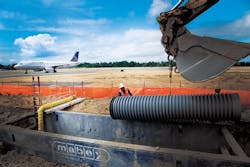About the author: Steve Cooper is a writer for SCA Communications. Cooper can be reached at [email protected].
Rebuilding the 46-year-old center runway at Seattle-Tacoma International Airport (Sea-Tac) involved more than just the pavement. To comply with strict Federal Aviation Administration (FAA) criteria regarding drainage within runway safety areas, as well as provide environmental enhancements for storm water runoff, the Port of Seattle, operator of the airport, also elected to upgrade the storm water drainage system.
“There were a variety of overlapping requirements that needed to be met,” said Chris Coulter, P.E., of engineering firm HNTB. “This included assurances that there would be zero ponding within the runway safety area, zero pipe failures, rapid pipe installation, meet FAA grant eligibility requirements and that the pipe would be structurally robust for use within the runway safety area.
“Furthermore, the port has very strict monitoring requirements for storm water release, so we needed a product that had proven joint reliability. Our aviation group in the Seattle office was contacted to assist with the storm water conveyance design for the Runway 16C/34C reconstruction project. The system drains the center of the airfield, which encompasses about 145 acres of both airfield pavement and runway safety area.”
High-Traffic Needs
Built in 1969, Runway 16C/34C is the oldest of the three runways at the northwest U.S.’s largest airport and is 9,426 ft long. The surface is made up of more than 4,000 concrete panels, more than 600 of which have been replaced during the past 20 years to keep the runway operational. The $95 million total reconstruction project was completed in October 2015.
“The runway we were reconstructing had outlived its useful life by about 20 years,” said Coulter, the QA/QC construction manager for the project. “So it was long overdue for reconstruction, and while doing that much work in a short amount of time, the port wanted to make sure all bases were covered.”
The project needed to include new storm water conveyance infrastructure to improve drainage from the paved areas and bring the infield area to a better state for deviation of aircraft from paved surfaces, according to Coulter. The team also had to eliminate standing water to minimize bird activity. The final system design had the capacity for a 24-hour, 100-year storm and used approximately 3 miles of pipe to provide the required hydraulic characteristics.
The Port of Seattle’s NPDES permit requires the airport to meet water quality standards before water is discharged. The water enters a storm drainage detention system and then is released to pre-development flow conditions before entering the natural waters of the state. Storm water entering the new system from 80 catch basins goes through compost-amended filter strips in the runway safety area before entering the catch basins. It then goes to the storm water vault and is released at the pre-development outflow rate.
Pipe Selection
The storm water management system used 16,000 ln ft of 12- to 36-in.-diameter pipe, most of which was thermoplastic SaniTite HP pipe from Advanced Drainage Systems Inc. (ADS).
“Any of the pipe we put down within the runway safety area—within 250 ft of the center line of any of the runways—we wanted to make sure that it can stay there for the foreseeable future,” Coulter said. “We do not want to have to get back in, close the runway to deal with a pipe issue. In other words, any pipe that is out on the airfield, if we had to dig it up and replace it, would cause at least one of the runways and several of the taxiways to get shut down. The operational impact to the airport and airlines would be detrimental if we had to do an unscheduled runway closure.”
The pipe’s stiffness and beam strength minimizes deflection and enhances long-term performance. It meets ASTM Standards F2736 and F2764, and exceeds ASTM Standard D3212 for water tightness with dual gaskets and a banded reinforced bell. Made from engineering-grade polypropylene, its designed service life exceeds 100 years. Burial depth at the airport ranged from 4 to 12 ft.
In 2014, the FAA approved polypropylene pipe for subsurface water collection and disposal at civilian airports. Design engineers and contractors can leverage the benefits of the lightweight, cost-effective and durable solution for water collection and removal under airfield pavements. This action followed the FAA approval of high-density polyethylene pipe (HDPE) for under-pavement use in all airport areas including deicing pads, runways and taxiways.
Finishing on a Tight Schedule
Coulter has more than 18 years of engineering experience. Most of that time, he said, has been spent overseeing pipe being put into the ground at Sea-Tac.
“We’ve gone away from [reinforced concrete pipe] out here a long time ago,” Coulter said. “It just doesn’t do anything for us with time savings. The ADS pipe comes in longer 20-ft lengths, and that also means a lot fewer joints along the entire system.”
The project team had to complete the pipe replacement project in 180 days without shutting down the entire runway. The port required the pipeline to be air tested for joint integrity. According to Coulter, this could have caused delays.
“Under a tight construction schedule, that has been a problem in the past. Early on, we could see that the SaniTite HP pipe was holding up to the required air pressure testing and it went very well,” he said. “With the SaniTite HP pipe, the double-gasketed seal allowed our air pressure testing to go off without a hitch. This gave us the confidence to lay pipe quickly, backfill and air pressure test it when we could with a high degree of assurance that it would pass.”
To increase the efficiency of draining the field, 8,640 ft of 6-in.-diameter, perforated N-12 HDPE pipe was installed around the perimeter.
About the Author
Steve Cooper
Steve Cooper is a writer for SCA Communications. Cooper can be reached at [email protected].
